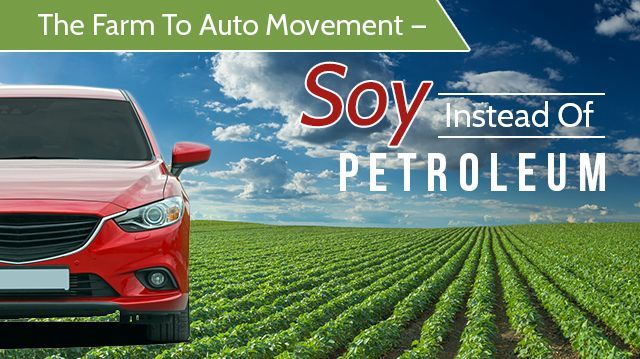
When you think of the products making up car components, soybeans probably aren’t the first things that come to mind. Each Ford vehicle produced in North America contains a minimum of 20 pounds of soy foam. That translates into 25 million pounds annually in reduced petroleum use and carbon dioxide emissions. It also reduces vehicle weight, aiding fuel efficiency.
Soy foam is used primarily in seat cushions, and Ford has produced a YouTube video called, “Why Would You Sit on a Soybean?” to promote its use of sustainable materials. Another plus: soy-based foam is safer than conventional foam for people with lung disease. Company tests confirm that customers can’t tell the difference between sitting on soy foam versus petroleum-based foam.
Ford biomaterials
Dr. Deborah Mielewski founded the Ford biomaterials program in 2001. Now the senior technical leader of materials stability at the company, she and her team went through a lot of disappointments before the oil crisis. In conjunction with the international financial meltdown, executives were pushed to take a closer look at using sustainable materials. In 2007, every Ford vehicle contained at least 300 pounds of petroleum-based plastic. In 2008, the soy-based foam seating was introduced in the Ford Mustang and, in the span of a few years, it was part of every Ford vehicle.
The Ford Motor Company Media Center states that “soy-based foam is up to 24 percent more renewable than petroleum-based foam.” Mielewski is quoted, saying, “As the world’s population continues to swell and resources become scarce, my gut is telling me that providing sustainable options to petroleum-based plastics is heading in the right direction. We can make cars that are better for the planet and we can change the way the world moves.”
Old jeans and other recycled materials
A recycler by nature and upbringing, Mielewski reuses in both her professional and personal life. She and her team were responsible for the use of “shoddy” in mats in the F-150, the Escape and the Fusion. Shoddy is a mix of cotton that in a former life was old jeans, bath towels and T-shirts, among other products. The mats are used under the carpets in these vehicles for sound absorption, making travel much quieter. The use of shoddy keeps millions of pounds of cloth and old clothes out of landfills.
A new use for old money
In its pursuit of recycling and reusing, Ford is considering the use of shredded paper money. Those old bills are printed on high-quality linen and cotton fiber. Every day, as much as 10,000 pounds of old greenbacks are shredded, then either burned or sent to landfills. Ford is working on plans to put that old money to use in interior bins and trays.
Durability is the priority
Mielewski points out that “incredible durability” is necessary for any of the products used by the automaker. Bio-based materials must perform as well — or better — than the petroleum-based plastics they are designed to replace, or they aren’t used. That’s why every biomaterial is evaluated for durability and performance, along with cost-effectiveness.
New possibilities
Currently, Mielewski and her colleagues are investigating the possibilities inherent in bamboo and algae. The former grows extremely rapidly — making it an invasive species in many locales — and could replace plastics in certain uses. Algae also reproduce quickly, and could become a sustainable biofuel. For now, Ford is considering it as another material for its seat cushions. Mielewski sees potential in agricultural waste products, and Ford has already used wheat straw as a component of some vehicle storage bins. Partnering with local farmers minimizes shipping and related costs as well, another environmental advantage.
Ford’s future
Mielewski’s role at Ford includes thinking globally about recycling, reusing and minimizing environmental impacts. Ford has publicly committed to increasing the amount of renewable or recyclable materials in every model year, for every program. For example, recycled plastic bottles will soon become part of fabrics used in the F-150 line. That’s five million bottles kept out of landfills annually. Mielewski told GreenBiz that she defines success as seeing such materials actually implemented in the company’s production vehicles.
—Jane Meggitt
Jane Meggitt graduated from New York University and worked as a staff writer for a major New Jersey newspaper chain. Her work on pets, equines and health have appeared in dozens of publications, including The Daily Puppy, The Nest Pets, Horse News, Hoof Beats and Horseback magazines.
Sources:
http://eco-chick.com/2015/11/34409/how-the-farm-to-car-movements-leader-debbie-mielewski-of-ford-works-heroines-for-the-planet
https://www.greenbiz.com/article/how-she-leads-debbie-mielewski-ford-motor
https://media.ford.com/content/fordmedia/fna/us/en/people/debbie-mielewski.html
http://unitedsoybean.org/article/sustainability-drives-soy-innovation-at-ford
http://ivn.us/2012/04/21/mo-money-no-problems-ford-researching-sustainable-uses-for-retired-greenbacks
http://www.dwell.com/interviews/article/your-next-car-might-literally-be-made-money

